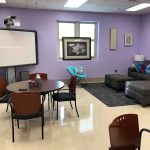Reprinted with permission from the Wisconsin Association of School Boards. Original Story from the Wisconsin School News Magazine, August 2019, page 4. | Image from The Journal Times
Public school districts across the country are continually adapting to an ever-changing world. With independent charter schools and private schools, public school districts are forced to always be on the top of their game — now more than ever. Public schools must provide choices for students and parents, offer top-of-the-line curriculum, and provide a safe environment for all students and staff. Most importantly, public schools must prepare each of their students for college, career and life. In order to be successful at this, change — and sometimes a lot of it — is required. Racine Unified School District (RUSD) is no stranger to this change.
In the fall of 2012, RUSD began the journey to transform its middle schools to address declining enrollment, inefficient use of facilities, and a poor reputation. The district’s research showed that families wanted more choices and opportunities, safe and engaging learning environments, and a challenging curriculum.
All families in the Racine Unified School District live within the radius of three K-8 schools. Families could choose to attend the school in their district or select from one of four other specialty middle schools. The district’s transformation plan included:
- Moving a school to a different building
- Closing an existing middle school
- Combining a high-performing elementary school with a low-performing middle school to create a fine arts K-8
- Revising all middle school boundaries
But, just having a plan is not where the story ends. RUSD’s biggest challenge would be securing stakeholder buy-in and support, primarily from middle school staff and families. Their solution: a week-long Kaizen event.
Racine Unified School District Takes on ‘Kaizen’
Kaizen focuses on continuous improvement, or “small incremental improvements” of all areas of a company. A Lean Six Sigma tool, the Kaizen process gathers stakeholders in one place, maps the existing process, improves on it, and solicits buy-in from all parties. The Kaizen process proved to be the key to the district’s success. By spending five full days together, with stakeholders focused on the identified issues and plans, district leaders brought the necessary people on board from the beginning and built strong relationships that carried through the planning and roll out. Because of the success of the Kaizen, teachers and school staff, rather than administrators, led much of the actual implementation work.
Due to lack of support from staff, including union employees in particular, previous attempts to initiate change in the district failed. So, the communication team suggested trying Kaizen. They hoped to not only build buy-in for the plan, but to encourage staff and union leadership to partner with district administration in implementing the middle school transformation plan. The Racine Unified School District superintendent agreed to try it. Participants included a diverse group from across the district, including administrators, teachers, school leaders, union-recommended representatives (teachers) from each impacted school, union leaders, parents and a middle school student.
The district partnered with Gateway Technical College in implementing Lean Six Sigma strategies. They also contracted a talented Kaizen facilitator, who effectively led this diverse group of stakeholders. The facilitator navigated through landmines and relationship issues that stymied district-wide change in the past. The work proved to be challenging and intense.
The Kaizen required communicating honestly and openly, dropping titles at the door, and committing to work together in the best interest of students.
“The fact that everyone was at the table was important; the fact that everyone had an equal role at the table was huge,” said Dani Dickert, a middle school teacher and teacher’s union representative. “It was the first time I had been part of something where I really felt I was on the same level as the administrators who are actually my bosses.”
The group met in March 2017. On the first day, administration outlined the necessity of the middle school transformation. Tough conversations followed about trust and past problems, what is best for students, current challenges and possible solutions. By day two, the group agreed to work through the plan proposed by the administrative team. By the end of the week, work plans emerged from four committees to ensure the transformation would happen for the 2018-19 school year.
Working Together to Make Change Happen
Typically when significant change happened within the district, district administration would lead the work. However, using the Kaizen process, teachers and school staff led the teams. Bob Debbink, a 30-year Racine middle school teacher, participated in the Kaizen and told the school board he had never been part of something so collaborative.
“In all my years at the district, I have been on a lot of committees. But none has ever come close to this type of collaboration,” Debbink explained. “All voices were heard and all people were at the table.”
Throughout the summer of 2017, the teams worked together to make change happen — and happen quickly.
- The communication and marketing team developed the tag line ‘My School. My Choice.’ It was the brainchild of a teacher on the committee. The group also developed a marketing and communication timeline as well as a budget.
- The transportation, enrollment and boundaries team developed a timeline for deciding on and bringing to the school board a plan for new middle school boundaries, as well as a plan for accommodating transportation to choice schools. The team also mapped out what the enrollment process would look like.
- The programming team focused on the underlying issues plaguing the middle schools and plans for addressing them. This included curriculum, programming, family engagement, and more.
- The staffing team focused on the middle school staffing displacement and hiring processes, and communicating the process to middle school teachers throughout the year.
Many of these changes required approval by the school board and all the changes required board member awareness. While this may seem daunting, the smooth and efficient Kaizen process offered growth opportunities for many district staff. The collaborative teams of stakeholders presented every update and recommendation to the board. This provided strong support for the collaborative decisions.
My School. My Choice.
With the planning work mostly complete, it was time to make sure that every middle school family made a choice.

With the support of the communications and marketing team, the district initiated a comprehensive communication and marketing campaign. It held ‘choice fairs’ for middle school families and parent information nights at all the elementary schools. The district also distributed marketing materials countywide including yard signs, movie theater ads, and even ads on Pandora Radio.
Campaign Success
With the goal to attract and retain families, one of the signs of success for the middle school transformation initiative and the ‘My School. My Choice.’ campaign was an increase in the number of families intentionally selecting a middle school during the enrollment window. In 2016-17, 592 of the more than 3,500 middle school students chose a school. In 2017-18, the district launched ‘My School. My Choice.’ That summer, 1,848 middle school students selected a middle school, a 212 percent increase.
On Sept. 4, 2018, the district welcomed thousands of students into new and/or transformed schools. At the new Gilmore Fine Arts school, staff cut the red ribbon and welcomed students down a red carpet into their school for the first time. The school boasts renovated classrooms, fresh paint and a brand-new maker-space. At Starbuck Middle School, now an IB World School, students and staff filed in ready to take on new curriculum and new faces. Walden III Middle and High School and the REAL School took on the challenge of increased enrollment and navigating new buildings. Transformation happened.
In a little over a year, a team of stakeholders from all employee groups, some of whom had never met before and never led a change process before, came together to tackle what had seemed nearly impossible.
Racine Education Association President Angelina Cruz said it was a great and collaborative process. “It was an opportunity to bring a broad group of stakeholders together that were all going to be impacted by this change. The process allowed for all voices to be heard. It was the first time people started to come together and honestly discuss how to move forward together.”
During the process, families learned about the transformational changes happening in the middle schools. Staff learned the value of their voices and how to work together to drive transformational change.
This entire process and campaign helped the Racine Unified School District district build trust with staff. It also showed the district’s willingness to work together for students. The team remains committed to the process. They completed a six-month review of the implementation and are looking at other opportunities to enhance the experience of families in the campaign. In the fall of 2018, the district proved that true partnership and shared accountability can overcome almost any challenge.

Reprinted with permission from the Wisconsin Association of School Boards. Original Story from the Wisconsin School News Magazine, August 2019, page 4. | Image from The Journal Times



